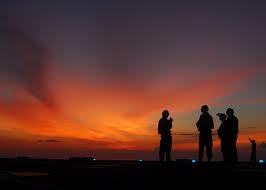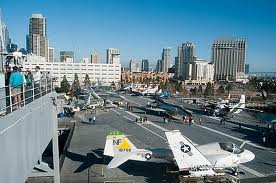Mar.09.2011
by Ed Beakley
4. Survival on her own terms: Midway’s Magic
Essence of Winning and Losing: For a warship, survival on your “own terms” means carrying out your mission, in this case sending combat sorties over North Vietnam. If Midway/CAG 5 can’t execute, some other ship/airwing must, maybe on a day they were due for a well deserved stand down from the stress and grind of combat. It’s not just the pilots, flight deck crews barely get a break between the 12 hour cycles of launch and recovery. And it’s hot in the Gulf of Tonkin, but add jet blast … Days off are vital. The faith must be kept.
It was a unanimous decision by the Captain and the CO’s to fly the next day. It is my recollection that every squadron CO, including me, flew on the 25th. VA-56 Commanding Officer CDR Lew Chatham.
But it was a long way from survival to operations …
Many of the stories are much shorter than Lew Chatham’s or Bruce Kallsen’s, but they are just as much woven into the fabric of the story of that night, and are necessary for comprehension of what it meant to sound flight quarters the next morning. Here from e-mails to me, from the Midway website Crew Messages, and from the book sold on-board by Scott McGaugh – Midway Magic; An Oral History of America’s Legendary Aircraft Carrier:
Edward McElhenney:I was in GM Div. and was assigned to the flight deck. I had just been relieved by Tom Toney when the crash occurred. I went to my GQ station on the flight deck and could not find him in all the activity that was going on. As a red shirt, EOD grabbed me and I helped throw bombs, missiles and rockets over the side. I remember seeing the injured being taken down on the bomb elevator on the starboard side. Tom Toney came around from the island and said he had gone down to get his rain gear and was lucky to have not been on the flight deck at the instant of the crash. What a night. We lost some great guys and some heroes were born that night for sure. Captain had us back in the saddle flying next morning.
Dr. Jim Wells, Midway’s senior medical officer: I remember that night well. I was the senior medical officer. I will always remember the outstanding job the corpsmen did rescuing and taking care of the injured. Unfortunately, I also remember many of the men we lost. We operated on the CAG that night to save his leg. The Air Force kept a plane on the ground in DaNang waiting for us to fly our injured over and then onto Clark. We lost one young sailor who aspirated JP5. The heroism that night was outstanding. The drills we all got tired of helped everyone to survive a terrible night.
Dr. Don Vance shouldn’t have been on the flight deck. His GQ station was the aft mess deck. But within seconds of the crash he found himself sprinting through the rain, kneeling near one victim, shouting orders, and then moving to the next. In his wake, corpsmen and flight crew administered to and sometimes carried victims in wire baskets over to the aircraft elevator that would take them below.
Only a week before, the medical department had received briefings on mass casualty procedures from personnel at Clarke Air Base in the Philippines. It made a difference. In the end four men died, including the A-6 BN Mike Bixel, VA-56 plane captain Clayton Blankenship, Robert Yankoski, and Robert Haakenson. Serious injuries totaled 27, requiring three emergency operations on board including on the leg of the airwing commander C.E. Meyers. Eleven men were flown into Danang just in time for a rocket attack. An unsung hero was an Air Force Colonel who held planes on the deck at Danang despite the “incoming” so the COD with the badly wounded could land
VA-115 A-6 pilot Dave Kelley: Here’s another part of the story: After I flew at night on the scary low-level missions, I used to go to the stateroom of the two dentists who were just around the corner from the stateroom I shared with Mike McCormick. The dentists would pour me a couple of fingers of scotch and give me a couple of small pills. I would drink the scotch, take the pills, and then go and sleep for 12 hours. Later I found that the pills were Valium, and they really did work.
After the accident I went to the dentist’s room. They were really shook-up. Since there were only 3 doctors aboard the ship, the dentists had been called to sickbay to help handle the victims of the crash. One of the dentists was a 2 + 4 dentist, i.e., he entered dental school after two years in college. That made him somewhere around 24 in 1972. He had been tending to a victim of the accident who needed to have his leg amputated. The dentist had performed the amputation. He was just about in shock. He said that he had never worked on a human in that type of operation. His only experience had been with a cadaver, when he was in pre-med. I prescribed a couple of fingers of scotch and some of the small pills. That seemed to take care of him.
Quoted from the Crew Messages - “I went down to the mess deck to give blood, but was turned away as so many responded ahead of me” - is reflective of the comments of many like Jack Forrestel, Albert Engel. and Jim Amondson who’s job and GQ station kept then far from the turmoil on the flight deck, but not from acting to make a difference.
And then there’s thisfrom Con Smith in reply to Courtney looking for information on her father who passed away in 1985 while she was a toddler: “I served with your father on the night of the plane crash in Oct. 72. We were in V-1 Division, flight deck crew. Gary Dick and Tom Bebee were on duty in the large crash truck that night when the crash happened. They responded very quickly and without fear of their own lives. A fire on the flight deck with bombs and jet fuel everywhere is a very dangerous thing. Because of their actions that night, I am sure they saved a lot of our lives. Your father is a real hero. From his old friend, Smitty.”
Courtney’s father, Gary Dick, drove the fire truck into the fire, when blinded by the rain and back wash of the retardant and unable to see, when directed by the Air Boss in Pri Fly above, he pushed on until surrounded by flame and extinguished the fire – total time 90 seconds.
War and Remembrance:
Schoolboy today sits in San Diego Harbor open to all looking to get a glimpse of the carrier environment. Note the VA-115 Intruder on display. USS Midway has introduced millions to Naval Aviation, refreshed many a memory and brought old friends back together. She is a bright and shiny representation of a highest reliability organization and singular monument to all who served and continue to serve their country as part of “Fly Navy.”
There is one hell of a lot more to Naval Aviation than us college boy, ne’er do well a-holes in speed jeans. If there was such a thing as Midway Magic, it was manifest - using the academic language of research – in the true “actionable understanding” of the carrier environment by Schoolboy’s flight deck personnel that night.
Midway Magic = High Reliability organization. When it all hit the fan, those young men knew exactly what to do and they saved our asses.

Happy 100th!
Return to INTERSECTION IV. and sub-pages:
1. The Pilot’s Story: Bruce Kallsen VA-115
2. Landing Signal Officer Perspective
3. Champs (and a Bear) In the Middle
Also see:


